THAILAND
Religion

Religion
Cities in THAILAND
| Bangkok |
Religion
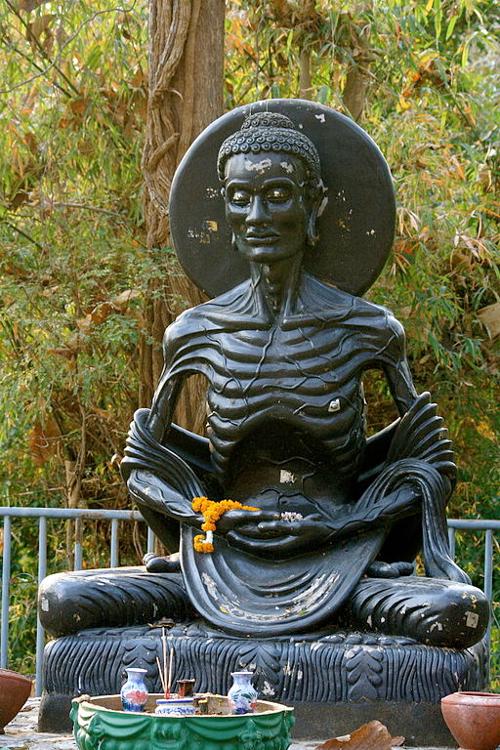 Fasting Buddha Chiang Mai, ThailandPhoto: Akuppa John Wigham CC 2.0 Generic no changes made
Fasting Buddha Chiang Mai, ThailandPhoto: Akuppa John Wigham CC 2.0 Generic no changes made
Buddhism was founded in the 6th century BC. in India The founder was Siddharta Gautama (560-480 BC). In Thailand our era is used, but the Buddhist census is also used. Although it is not known exactly when Buddha was born, the year of birth is 543 BC. The year 2004 is 2546 in the Buddhist era.
At the heart of Buddha's teaching are the four noble truths:
-Life is suffering.
-The cause of this suffering is the desire and attachment to life. As a result, man is trapped in an unwholesome cycle of birth, death and rebirth.
-By letting go of desire and detachment man can abolish suffering.
-The Eightfold Path (correct insight, life, striving, meditating, thinking, purpose, word, and deed) is the only way out of the unwholesome cycle of reincarnation and leads to nirvana, the state of bliss.
By adhering to some basic principles, man can his fate or 'karma' influence. The Five Commandments are: do not kill, steal, commit adultery, lie and use alcohol, tobacco or drugs.
Buddhism is not actually a religion, but a philosophical system and attitude. There are no gods. Buddhism has monks, but again no ecclesiastical organization. Traditionally, the king is the protector of all religions.
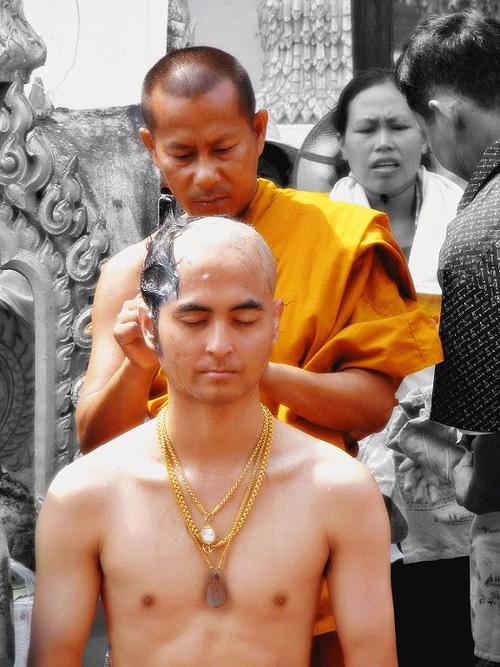 Head of a future priest is shaved in the tradition of therevada BuddhismPhoto:Tevaprapas CC 3.0 Unported no changes made
Head of a future priest is shaved in the tradition of therevada BuddhismPhoto:Tevaprapas CC 3.0 Unported no changes made
After the death of Buddha, the religion fell apart in two directions: the mahayana- Buddhism and Hinayana Buddhism.
Mahayana Buddhism starts from the universal salvation of all living beings and therefore becomes the 'great vehicle'. This school of thought knows Bodhisattwa's, mortals who have already attained enlightenment, but remain on Earth to show people the right way. Mahayana Buddhism has spread to include China, Nepal, Japan, Korea, and Vietnam.
Hinayana or Theravada Buddhism is also known as 'School of the Elderly'. This direction within Buddhism is limited to the individual salvation of man, without the intervention of others, and is therefore called the "little vehicle". Whoever reaches the enlightenment independently becomes 'arhat'. However, this status is reserved only for the monks. Lay people can at best add to their karma during their life on earth and be reborn in a higher position. One can increase one's karma by doing good works such as almsgiving to monks and donations to temples. The selfless giving or 'dana' is therefore the most important form of virtue that leads to good karma. Hence, it is sacrificed in Thailand. Followers of Hinayana Buddhism see themselves as the true continuators of the teachings of Buddha as recorded in the sacred scripture, the Tripitaka.
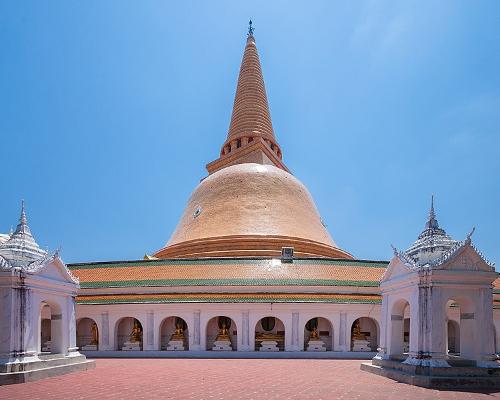 Phra Pathom Chedi, ThailandPhoto: Supanut Arunoprayote CC 4.0 International no changes made
Phra Pathom Chedi, ThailandPhoto: Supanut Arunoprayote CC 4.0 International no changes made
Phra Pathom Chedi is the tallest Buddhist structure in the world, located in the provincial capital of Nakhon Pathom, an hour's drive west of Bangkok. The beautiful ‘chedi’ (also called stupa - a bell-shaped reliquary hall with a pointed roof) is 120 meters long, is covered with gold-orange tiles and is surrounded by a complex of additional 'bots', (a central chapel or consecration hall of a 'wat' ;) Buddha statues and other remarkable structures. The top of the tower has a golden trident, symbol of the Hindu god Shiva, with the royal crown of Thailand on top.
The most famous new Buddhist sect is Santi Asoke 'Peace and no Samrt'), which was founded by Phra Bodhirak. He is half Chinese and was a TV producer and singer. His followers were removed from 'sangha'. An important theme in their group is that monks should mingle with people and not be aloof from politics.
Other influential sects include Dhammakaya 'Body of Truth' and Suan Mokh ('Garden of Liberation').
The state religion in Thailand is Theravada Buddhism, which is practiced by approximately 94% of the population and which dominates almost all cultural and public life. Principles such as tolerance and open-mindedness are essential and great emphasis is placed on the sanctity of family, friends and social harmony.
In Thailand there are several schools within the Theravada, which apart from theoretical debates, among other things, distinguish themselves from each other by the demands they place on their followers.
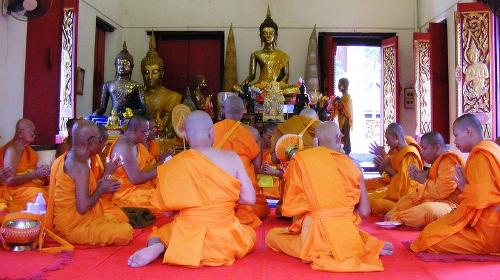 Mendicants, ThailandPhoto: Tevaprapas CC 3.0 Unported no changes made
Mendicants, ThailandPhoto: Tevaprapas CC 3.0 Unported no changes made
Every Thai man should return as a 'bhikku' ('mendicant') for several months or weeks, migrate in a kind of monastic community ('sangha'), of which there are about 32,000. Usually this period falls between school or university and a job, career or marriage. It is clear that things are different in modern times. Today, many Thais consider this duty to be a troublesome and completely unnecessary exercise.
Thai Buddhism exhibits a high degree of tolerance towards other religions.
Bangkok has the highest concentration of important temples. The most famous temple is Wat Phra Keo, also called the Temple of the Emerald Buddha, which houses the mysterious Emerald Buddha statue, a Thai national symbol. It was built in 1782 next to the Grand Palace and is used as a ceremonial temple of the Thai kings.
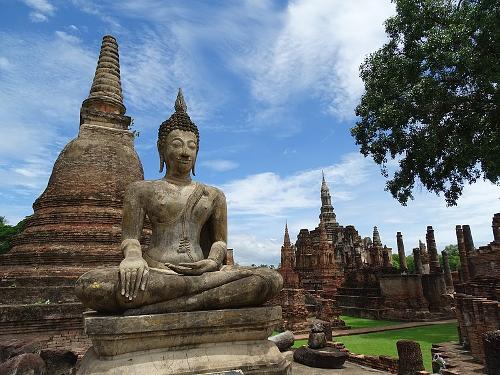 Wat Mahathat ThailandPhoto: Adam Jones CC 2.0 Generic no changes made
Wat Mahathat ThailandPhoto: Adam Jones CC 2.0 Generic no changes made
Wat Mahathat is the main temple of the largest monastic group, the Mahanikai. The national headquarters of the Thammayut sect is Wat Bowonniwet. Wat Po is the largest and oldest 'wat' (Buddhist Monastery) in Bangkok and contains the largest collection of Buddha statues in Thailand. The total number of Buddha statues in Thailand is estimated to be over five million. Ancient religious scriptures contain strict regulations for images of Buddha. These had to exhibit 32 primary and 80 secondary characteristics and have four basic postures: standing, sitting, walking or lying down.
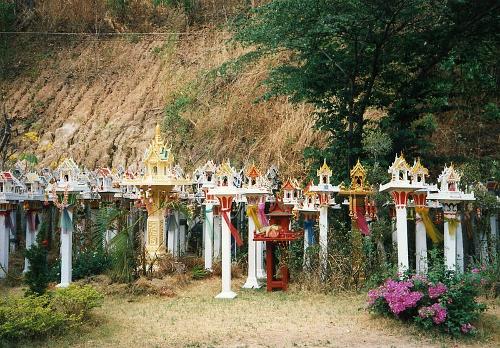 Phra Phum ThailandPhoto: W. Horsch CC 3.0 Unported no changes made
Phra Phum ThailandPhoto: W. Horsch CC 3.0 Unported no changes made
Yet Buddhism is not the only religion in Thailand. Forms of animism or spirit worship have also been preserved and have found their place within Buddhism. Most Thai still believe in the powers of the supernatural and are convinced that these are intertwined with everyday life. Tattoos, amulets, fortune tellers and shamans still play an important role in everyday life. Also, the spirit that watches over the house is still revered by almost all Thai. The Thai world is full of 'phii', ghosts for which houses ('phra phum' is the old name in the Khmer language) must be built so that they won't cause mischief. It does not matter whether these are small and simple as bird houses or meters high and as beautiful as a temple. There is always incense burning, fresh flowers and food.
Thailand has more than three million Muslims, mainly Malays in the southern provinces of Satun, Pattani, Yala, Narathiwat, Phuket, Krabi, Trang and Songkhla. Muslims regularly complain of social and political discrimination and radical Islamic groups use these sentiments to garner support for autonomy or affiliation Malaysia. In the 1990s, the Thai government has responded to various Islamic wishes and recognized laws that regulate conflicts over marriage, estate and other family matters. Christianity (predominantly Roman Catholic) is primarily represented among residents of Chinese descent.
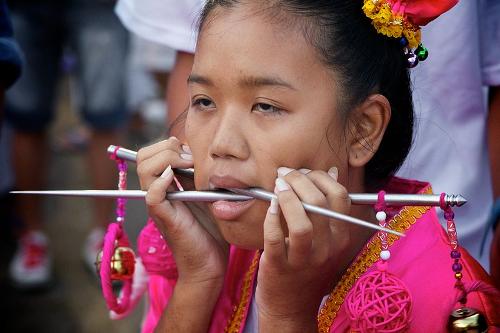 Vegetarian festival, Phuket ThailandPhoto: Joseph Ferris III CC 2.0 Generic no changes made
Vegetarian festival, Phuket ThailandPhoto: Joseph Ferris III CC 2.0 Generic no changes made
None of this could prevent at least 74 insurgents from being killed in fighting between the Thai army and rebels in the Muslim south in April 2004. The government accused the militant Muslims of a wave of violence that started as early as January of that year. Sixty people were also killed and there were fears of a return of Islamic separatism in the south of Thailand.
The nine-day Chinese Taoist Vegetarian Festival takes place in Phuket City every September / October in September / October. This party is one of the most spectacular in Thailand and some of the rituals performed are absolutely unsuitable for sensitive onlookers. Some priests and mediums put their faith in the Taoïst deities by chastising themselves, piercing their tongues and cheeks with spears, piercing their backs with hooks of meat, and walking over glowing coals as if in a trance.
Sources
Clutterbuck, M. / Thailand
Van Reemst
Davies, B. / Thailand
Kosmos-Z&K3
Forbes, A. / Thailand
Kosmos-Z&K
Hahn, W. / Thailand
Van Reemst
Hauser, S. / Thailand : mensen, politiek, economie, cultuur, milieu
Koninklijk Instituut voor de Tropen
Hoskin, J. / Thailand
Van Reemst
Macdonald, P. / Thailand
Kosmos-Z&K
Miethig, M. / Thailand
Lannoo
Peterse, L. / Thailand
Gottmer/Becht
Steinmetz, P. / Thailand
Elmar
Thailand
Uitgeversmaatschappij The Reader’s Digest
Thailand
Lannoo
CIA - World Factbook
BBC - Country Profiles
Copyright: Team The World of Info